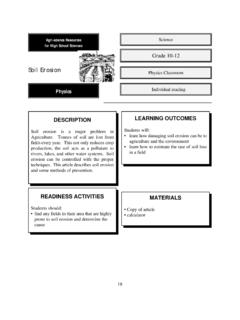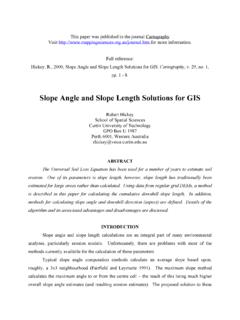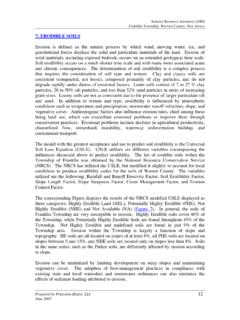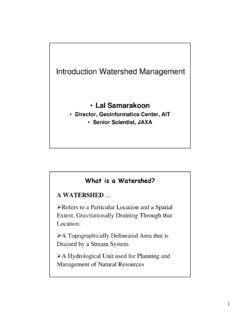Transcription of Revised Universal Soil Loss Equation
1 Understanding erosion with the Revised Universal soil loss Equation Towards a Better Understanding of the What, Why & How erosion is a process of detachment and transport of soil particles by erosive forces. Erosive forces include raindrop impact and surface runoff from rainfall. I. n Types of erosion Impact erosion - Physical detachment of soil particles as a result of raindrop impact. Sheet erosion - Thin, uniform wearing away of the uppermost surface layers in the soil profile. Seldom the detaching agent, but just merely transporting soil particles detached by raindrop impact. Rill erosion - Follows sheet erosion . As the amount and velocity of water increases water is now able to both detach and transport soil particles.
2 Gully erosion - As rills deepen and widen, gullies form. Simple definition: gullies are rills that are too large to be repaired with conventional tillage equipment. Channel erosion - erosion as a result of concentrating and confining the erosive forces of water. Includes both manmade and natural channels. Mass Wasting- Large failures usually as a result of gravitational forces. Landslides, pot-slides, slumps, debris torrents. Revised Universal soil loss Equation (RUSLE). original purpose was for agricultural activities as a result of the dust bowl era certain other adjustments made for construction activities used to estimate average annual soil loss only considers sheet and rill erosion does not consider gully erosion , stream bank erosion , mass wasting (landslides).
3 A simplified approach that assumes static conditions does not consider the unpredictable human element its primary use is as a predictive tool to evaluate land use options a linear formula so its EZ to work with, and also somewhat EZ to remember A= R K L S C P. Rickleskip Revised Universal soil loss Equation (RUSLE). A= R K L S C P. A= average annual soil loss R= rainfall-runoff erosivity factor K= soil erodibility factor LS= slope length and steepness factor C= cover management factor P= support practice factor NO, you are not expected to remember this formula, its an understanding of the basic concepts that is important. A Average Annual soil loss [tons per acre per year]. estimates average erosion in tons per acre per year an annual average loss over a site where losses at various parts of the site may differ greatly from one area to another this is what you want to reduce by working with the other variables in order to evaluate options you need to work with the other variables in consideration of the underlying assumptions and limitations Those other variables are?
4 R Rainfall-Runoff Erosivity Factor a measure of the erosive force and intensity of rain in a normal year values of R have been computed from rainfall records and probability statistics across the United States, so should not be considered as a precise factor for any given time or location need to make adjustments for runoff from snow melt and freeze- thaw conditions its principal value, and that of the soil loss Equation itself, is as a predictive tool and risk evaluator R Rainfall-Runoff Erosivity Factor May be determined from isoerodent maps depicting yearly average values, or tables and charts that can break it down to a percent by month basis. Adjustment factor for estimating monthly and periodic portions of annual soil loss .
5 Ukiah (R=59). Month Percent Isoerodent Map for Northern California January 11. February 16. March 11. April 6. May 3. June 5. July 4. August 3. September 4. October 5. November 15. December 17. TOTAL 100. **Source: Internet- USEPA Rainfall Erosivity Factor Calculator R Rainfall-Runoff Erosivity Factor You can not do much about the weather except work around it and schedule your activities appropriately, and try to use it to your advantage. schedule grading activities in the drier portions of the year, yet while trying to take advantage of soil moisture conditions schedule accordingly when transplanting or seeding to increase chances of success Just remember when gambling with the weather, being this is a 44 %.
6 Chance storm event that could just blow your project clean off, you've got to ask yourself one question: 'Do I feel lucky?'. Well, Do you punk !!! . K soil Erodibility Factor a measure of the susceptibility of soil particles to detachment and transport by rainfall and runoff soil texture is the principle factor affecting K, but soil structure, organic matter and permeability also contribute soil texture- sand, silt and clay with 12 variations soil structure- how individual soil granules clump or bind together, and therefore, the arrangement of soil pores between them determined from NRCS soil survey data, or by particle analysis, (ASTM D-422 hydromoter analysis). K soil Erodibility Factor soil K Value Nomograph soil Texture Nomograph K soil Erodibility Factor Generalized soil K.
7 Characteristic High clay content resistance to detachment decreases erodibility Course textured even though these soils are easily detached sandy soils they produce low runoff Medium textured moderately susceptible to detachment and silt loam soils produce moderate runoff High silt content > most erodible of all soils because they are easily detached; tend to crust and produce high rates of runoff K values range from to K soil Erodibility Factor There is not much you can do about the material you are working with. But, a small understanding of the basic principles used to determine the soil erodibility factor can be used to your advantage nomograph assumes 15% rock (size > 2mm), 15 35% reduces K by 50 58%.
8 Nomograph assumes 2% organic matter, 4% reduces K by 30 - 35%. compact soils increase K because of reduced permeability high pH (alkaline) increases K (BMP - dispose of concrete waste water properly). Focus of RUSLE is on erosion not structural integrity . on roads we want compaction / less compact soils are good in off shoulder areas higher rock contents are good everywhere Organic matter reduces erodibility because it reduces the susceptibility of the soil to detachment, and it increases infiltration, which reduce runoff and thus erosion . Its also beneficial for establishing vegetation. (BMP- stockpile the top soil layer separately for broadcast application prior to final erosion control.). LS Slope Length Steepness Factor quantifies the combined effect of slope length and slope steepness based upon experimental data - the ratio of soil loss per unit area on a site to the corresponding loss from a foot long experimental plot with a 9 percent slope reducing slope gradient and effective slope length will reduce the LS factor LS factors for different slope angles and slope lengths are conveniently summarized in tables LS Slope Length Steepness factor NRCS Unit Plot, LS=1.
9 LS Values for Freshly Prepared Construction and other Highly Disturbed soil , with Little, or no Cover (Renard, et al. 1987). LS Slope Length Steepness Factor LS is the slope length from the ridge to the point where deposition starts to occur near the bottom of the slope assumes uniform slope convex slopes tend to increase soil loss , concave slopes tend to decrease soil loss as a general rule soil loss increases more with slope steepness than it does with slope length C Cover Management Factor the ratio of soil loss from land under specified crop or mulch conditions to the corresponding soil loss from tilled, bare soil the C factor reduces the soil loss estimate according to the effectiveness of vegetation and mulch at preventing detachment and transport of soil particles ( erosion control).
10 Lots of bang for the buck' by working with the cover management factor C Cover Management Factor Cover Management Factors for Construction Sites Vegetative Cover C factor Percent Reduction of soil loss None (fallow ground) 0. Native vegetation (undisturbed) 99. Temporary Ryegrass, 90% (perennial) 95. Temporary Ryegrass, 90% (annuals) 90. Permanent Seedlings (90%) 99. Sod (laid immediately) 99. Mulching (for slopes 2:1 or less). Hay ( tons/acre) 75. Hay ( tons/acre) 87. Hay ( tons/acre) 93. Hay ( tons/acre) 98. Wood chips (6 tons/acre) 94. Wood cellulose ( tons per acre) 90. Other Competent gravel layer 95. Rolled erosion control fabrics (for slopes greater than 2:1) variable C value by type P Support Practice Factor the ratio of soil loss with a given surface condition to soil loss with up-and-down hill plowing in agriculture, used to describe plowing and tillage practices for construction sites, reflects the roughening of the soil surface by tractor treads, rough grading, raking or disking practices that reduce the velocity of runoff and the tendency of runoff to flow directly down-slope reduce the P factor rough and irregular helps trap sediment (sediment control).








